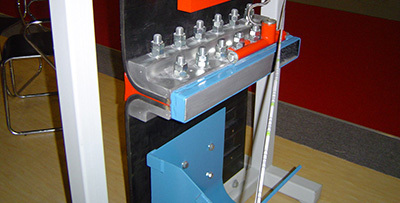News Center
Hezi technology focuses on the research and development of "rapid seamless conveyor belt joint sleeve" innovative technology project

NEWS CENTER

News Details
Innovative Solutions for Rubber Conveyor Belt Fasteners: Enhancing Efficiency and Performance
Release time:
2025-05-14
Innovative Solutions for Rubber Conveyor Belt Fasteners Table of Contents 1. Introduction to Rubber Conveyor Belt Fasteners 2. The Importance of Fasteners in Conveyor Systems 3. Types of Rubber Conveyor Belt Fasteners 3.1 Mechanical Fasteners 3.2 Bonded Fasteners 4. Innovative Solutions for Conveyor Belt Fasteners
Innovative Solutions for Rubber Conveyor Belt Fasteners
Table of Contents
- 1. Introduction to Rubber Conveyor Belt Fasteners
- 2. The Importance of Fasteners in Conveyor Systems
- 3. Types of Rubber Conveyor Belt Fasteners
- 4. Innovative Solutions for Conveyor Belt Fasteners
- 4.1 Hermetic Fasteners for Enhanced Seal
- 4.2 Modular Fasteners for Flexibility
- 4.3 Smart Fasteners for Monitoring
- 5. Choosing the Right Fasteners for Your Needs
- 6. Installation Tips for Optimal Performance
- 7. Maintenance Practices for Conveyor Belt Fasteners
- 8. Case Studies of Innovative Applications
- 9. Frequently Asked Questions
- 10. Conclusion
1. Introduction to Rubber Conveyor Belt Fasteners
In the realm of material handling, **rubber conveyor belts** are indispensable. They serve various industries, including mining, manufacturing, and food processing. Integral to the effective operation of these belts are the **fasteners** that join the belt ends together, ensuring seamless material transport. This article delves into **innovative solutions** that enhance the efficiency and performance of rubber conveyor belt fasteners.
2. The Importance of Fasteners in Conveyor Systems
Fasteners play a critical role in conveyor systems. They not only secure the belt but also influence several operational parameters. Properly designed fasteners can lead to:
- **Increased Durability:** Fasteners that withstand wear and tear extend the lifespan of conveyor belts.
- **Enhanced Safety:** Reliable fasteners reduce the risk of belt failure, which can pose safety hazards.
- **Operational Efficiency:** High-quality fasteners minimize downtime, allowing for continuous operation.
3. Types of Rubber Conveyor Belt Fasteners
Understanding the types of fasteners available is crucial for selecting the appropriate solution for specific applications.
3.1 Mechanical Fasteners
Mechanical fasteners are a popular choice for rubber conveyor belts due to their ease of installation and maintenance. They can be divided into several subcategories:
- **Lacing Systems:** These consist of metal laces that interlock to create a strong bond.
- **Clips and Buckles:** Simple yet effective, clip fasteners provide a quick solution for belt splicing.
3.2 Bonded Fasteners
Bonded fasteners utilize adhesives to secure the ends of the conveyor belt. This method offers a smooth surface and is ideal for applications where material spillage must be minimized. However, they require precise installation and curing time.
4. Innovative Solutions for Conveyor Belt Fasteners
As technology advances, so do the solutions available for rubber conveyor belt fasteners. Here, we explore some of the most innovative options on the market.
4.1 Hermetic Fasteners for Enhanced Seal
Hermetic fasteners provide a superior seal that is resistant to dust, moisture, and other contaminants. This innovation is crucial in environments where cleanliness is paramount, such as food processing or pharmaceuticals. The airtight seal prevents contamination and enhances the overall operational integrity of the conveyor system.
4.2 Modular Fasteners for Flexibility
Modular fastener systems allow for easy adjustments and replacements without the need for extensive disassembly. This flexibility is ideal for operations that require frequent changes in the conveyor layout or belt length. Modular fasteners also facilitate quick repairs, minimizing downtime.
4.3 Smart Fasteners for Monitoring
With the rise of Industry 4.0, smart fasteners equipped with sensors are gaining traction. These fasteners monitor parameters such as tension, wear, and temperature, providing real-time data to operators. By analyzing this data, companies can predict maintenance needs, prevent failures, and optimize conveyor performance.
5. Choosing the Right Fasteners for Your Needs
Selecting the appropriate fasteners for your rubber conveyor belt involves several considerations:
- **Application Environment:** Consider factors such as temperature, humidity, and exposure to chemicals.
- **Load Requirements:** Evaluate the weight and type of materials being transported.
- **Belt Design:** Ensure compatibility between the fasteners and the belt type.
6. Installation Tips for Optimal Performance
Proper installation is vital for the longevity and effectiveness of conveyor belt fasteners. Here are some essential tips:
- **Follow Manufacturer Guidelines:** Always adhere to the installation instructions provided by the manufacturer.
- **Ensure Alignment:** Misalignment can lead to premature wear and failure.
- **Use Appropriate Tools:** Utilize the right tools to ensure a secure fit without damaging the belts or fasteners.
7. Maintenance Practices for Conveyor Belt Fasteners
Regular maintenance is key to ensuring the ongoing performance of rubber conveyor belt fasteners. Consider the following practices:
- **Routine Inspections:** Regularly check fasteners for signs of wear or damage.
- **Tension Monitoring:** Ensure that the belt tension is within the recommended range to prevent slippage.
- **Cleaning:** Keep fasteners clean to avoid material buildup, which can affect performance.
8. Case Studies of Innovative Applications
Several companies have successfully implemented innovative fastener solutions to enhance their conveyor systems. For instance:
- **Food Processing Plant:** A facility adopted hermetic fasteners to eliminate contamination risks, resulting in improved product quality and compliance with safety regulations.
- **Mining Operation:** By switching to smart fasteners, a mining company was able to reduce downtime by 30% through proactive maintenance and real-time monitoring.
9. Frequently Asked Questions
What are rubber conveyor belt fasteners?
Rubber conveyor belt fasteners are components that join the ends of conveyor belts, ensuring they remain securely attached during operation.
How do I choose the right fastener for my conveyor system?
Consider factors such as the application environment, load requirements, and belt design when selecting fasteners.
What are the benefits of using hermetic fasteners?
Hermetic fasteners provide enhanced sealing, preventing contamination from dust and moisture, which is crucial in sensitive environments.
How often should I inspect my conveyor belt fasteners?
Routine inspections should be conducted regularly to identify any wear or damage that may affect performance.
Can smart fasteners really reduce downtime?
Yes, smart fasteners equipped with monitoring capabilities can help predict maintenance needs and optimize performance, leading to reduced downtime.
10. Conclusion
As industries evolve, the demand for innovative solutions in rubber conveyor belt fasteners grows. From hermetic seals to smart technology, these advancements enhance efficiency, safety, and operational longevity. By understanding the types of fasteners available and implementing best practices for selection and maintenance, companies can significantly improve their material handling processes. Embracing these innovations will not only ensure smoother operations but also provide a competitive edge in the ever-changing landscape of material transport.

Recommend News





























